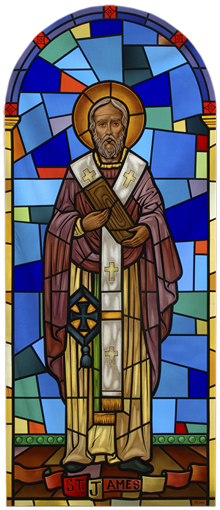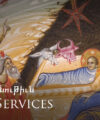 ST. JAMES OF NISIBIS
ST. JAMES OF NISIBIS
The patron saint of our church is St. James of Nisibis, one of the saints of the Christian Church of Mesopotamia. He was born in Nisibis, a town in northwestern Mesopotamia, now in southern Turkey and close to the border of Iraq. The non-Armenian Christian sources refer to him as the Moses of Mesopotamia because of his missionary zeal, tireless preaching, hermitic lifestyle, miracles and works.
According to the Armenian tradition, St. James was of Parthian origin and the son of King Diran of the Hephthalites and of Khos-ro-voo-hee´, St. Gregory the Illuminator’s paternal aunt. The same source maintains that he was nurtured and educated with St. Gregory the Illuminator in the town of Caesarea. This is one of the reasons why he was greatly venerated by the Armenians throughout the Middle Ages and in modern times.
In 325, he was one of the 318 bishops summoned to participate in the Holy Council of Nicaea (the first of the three ecumenical councils). His name appears among the signatories of the canons of the Holy Council and is classified in the Armenian translation next to the names of two other bishops from Mesopotamia.
Among his followers and immediate attendants there was a young Syrian, whom he had baptized and tutored the fundamentals of the faith. That person, named Ephrem, ultimately became one of the most important Christian writers and a saint of the Eastern Church. Ephrem’s writings were translated into Armenian in the fifth century and the Confession that we read every Sunday before Holy Communion consists of excerpts from one of his penitential writings.
St. James is best known for his attempt to climb Mt. Ararat. While resting on the slope of the mountain from his day’s tedious journey, the saint fell asleep. In his sleep, the angel of the Lord appeared and told him that God had spared him from the rigorous climb and that upon waking he would find a piece of the ark by his head. The saint did indeed find a petrified wooden plank, which he took with him to his See. The plank is now preserved in the treasury of Holy Etchmiadzin and is on display. At the site where he rested, a monastery was later built and named after him. In 1840 the monastery and the nearby village of Agori, which was at an altitude of 8,000 feet on the slope of Mt. Ararat, were totally destroyed by a massive earthquake.
St. James died in 338 AD and was buried in Nisibis. Soon after, the Persian siege of 350 took place. When the Persians took the city in 363, the pious Christians exhumed the body of their beloved bishop and took it elsewhere. Ultimately, his relics were distributed to various churches, as was common practice with the relics of confessors and martyrs. Some of St. James relics were kept in Armenian monasteries and churches.
Besides being commemorated with the 318 holy patriarchs of the Council of Nicea, St. James is honored in mid-December, on the Saturday preceding the fourth Sunday of Advent. He also has a set day of remembrance on December 15, when his life is read from the menology, or Haysmavoork. The tenth century poet St. Krikor of Nareg has an encomium dedicated to St. James and the 12th century Catholicos and poet St. Nersés the Graceful is the author of the hymn (Victorious and Holy Patriarch) that is, to this day, chanted in our churches on St. James’ day of commemoration.



